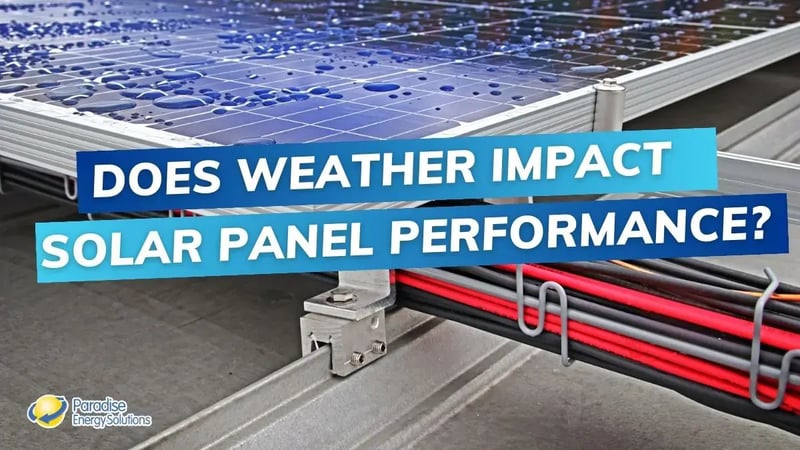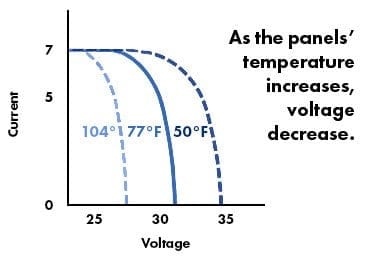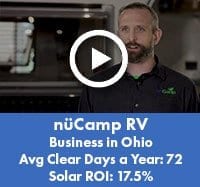
Each hour, 430 quintillion Joules of energy from the sun find their way to Earth. That’s more energy than the entire planet uses in one year.
While a fraction of that energy finds its way to a solar panel and is converted into electricity, it isn’t a perfect energy swap. The amount of energy produced depends on a few things, like how efficient the panel is, its orientation towards the sun, and of course, the weather.
How does weather affect solar panels’ performance? Everything from temperature to cloud cover has an impact on how much electricity your system generates.
The Best Temperature for Solar Panels
Think about the perfect day for solar panels. Of course, the sun is shining in the clear, blue sky. But what’s the temperature like? Believe it or not, it’s cold, not warm.
Like other electronics, solar panels work more efficiently in cold temperatures, allowing the panel to produce more voltage, thus more electricity. As the temperature rises, the panel generates less voltage and becomes less efficient, producing less electricity.
How much of an effect does temperature have on production? To find this out, you can take a look at the spec sheet for different panels. The numbers on these sheets come from various tests conducted by the manufacturer. In general, for each degree above 77 degrees (known as standard testing condition, or STC), your panel will become one percent less efficient. For each degree below 77 degrees, it will become one percent more efficient.

But even though solar panels are more efficient in the cold weather, they don’t necessarily produce more electricity in the winter than the summer. The sunniest weather is often in the summer when the temperature is the warmest. In addition to fewer clouds, the sun is out for a longer part of the day, so even though your panels are less efficient in warm weather, they will likely produce more electricity.
Do Solar Panels Produce in Cloudy Weather?
Anything that stands between your panels and the sun, be it clouds in the sky, fog on the surface, or shade from a nearby tree, reduces the amount of solar energy your system produces. But just like you can still get sunburnt on cloudy days, your panels could still be producing electricity, depending on how thick the cloud coverage is.
On a partly cloudy day, your production can drop by 10% to 25%, depending on how frequently the clouds pass over your system. But something called the “edge of cloud” effect can actually intensify the sunbeam and can lead to a brief increase in electricity production. If fluffy cumulus clouds pass in front of the sun, the wispy edges act as a magnifying glass, causing a stronger beam of sunlight to hit your panels!
What about overcast days? A quick way to check if your system is producing energy is to look for shadows outside. If you can see objects casting a shadow, your system is probably producing in some capacity. If you don’t see a shadow, it’s likely that the cloud coverage is too thick to produce electricity.
All in all, estimates are that your panels will produce about 10 - 30% of the electricity on cloudy days as you would on sunny days, but don’t let that keep you from going solar. Even if you live in an area that has less sun than Southern California and Arizona, it still could be a lucrative investment.
Portland, Oregon and foggy San Francisco both rank on the US’s top 20 cities for solar. And despite being much cloudier and 1/28th of the size of America, Germany produces 45.9 GW to the US’s 49.6 GW.
Solar installers should take into account cloudy weather when calculating your system’s production in your solar quote as well, so you’ll be prepared to make a well-informed decision based on your situation. And if you live in an area with net metering, you’ll be able to use the electricity your system overproduced on sunny days to cover electricity on cloudy days.
Will Solar Panels Work in the Rain and Snow?
While the rain itself will have no impact on the panels, the rain clouds will likely lower your production. However, the occasional rainstorm could actually be good for your solar system’s production, because it’s a no-fuss, safe way to clean your panels. Consistent rainstorms keep a layer of dirt or dust from covering the panels and blocking the light, which could lead to a decrease in production.
Though not yet a widely viable option, scientists have been working on a new kind of solar panel that could still produce electricity when it’s raining. Termed hybrid solar panels, these solar cells collect energy from both the sun and the rain. As precipitation hits the panels, the force from the impact is converted into electricity. When it’s sunny, they act just like traditional solar panels (but are still less efficient for now).
What about when that rain freezes into snow? Unlike rain, which doesn’t accumulate on the panels and block light, snow will have an impact on production beyond cloud coverage. After all, what blocks the sun from your panels blocks the panels from making electricity. However, depending on the weather following the snowstorm and the tilt of your panel, even heavy snowfalls will melt and slide right off your panels in no time.
Even though solar energy is dependent on the sun, it is still a great option for many homes, businesses, and farms in the cloudy, rainy, or snowy areas of the country. But don’t just take our word for it! Hear from two businesses who made the switch to solar in Ohio and Upstate New York.


Curious how much electricity you could produce in your local climate? Get your free solar quote that will show your system’s payback tailored to your area’s weather.





